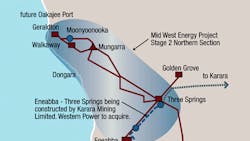New 330-kV Transmission Line Will Secure Supply and Underpin Development in Western Australia
The State Government of Western Australia announced it had approved funding for one of the largest transmission line projects ever undertaken in Western Australia - the Mid West Energy Project - Stage 1 (Southern Section). The new $443-million transmission line project will secure future development in the Mid-West region.
Energy Minister Peter Collier said the Liberal-National Government’s commitment to the project represented a significant benefit to the region.
“The 330kV transmission line will enable the connection of new mining projects at Three Springs, facilitate the connection of new sources of electricity generation in the Mid-West and secure power supplies for the people of the region,” Collier said.
“The construction of this transmission line and associated works is due to commence in June and will utilize up to 300 construction workers over a two-year period.
“The Mid West Energy Project will provide more than 500 MW of additional capacity for the Mid-West region. This is equivalent to supplying 500 large supermarkets with typical peak power demand.”
The 189-km transmission line will run from Neerabup (north of Perth) to Eneabba. It then connects with the 70-km line between Eneabba and Three Springs, being constructed by Karara Mining Limited. This line will ultimately be purchased as a part of the Mid West Energy Project and will service both the Karara mine site and the broader region through the Three Springs Terminal substation.
Between Neerabup and Eneabba, more than 2,000 wooden power poles will be removed and replaced with 387 transmission towers.
Planning has started on Stage 2 of the project to extend the 330-kV line a further 160 km north to Geraldton (Moonyoonooka).
When combined with Stage 1, the project will facilitate the construction and operation of several other major Mid-West infrastructure developments, including Oakajee Port and Rail, and the proposed Oakajee Industrial Estate adjoining the port.
Current plans are that the double circuit section of the line will initially be operated with one circuit at 132 kV and the other at 330 kV. When additional capacity is required to meet Mid West mining loads or additional generation, the line can be operated with both circuits at 330 kV for a relatively modest additional cost. Other than at the substations along the route, there will be no changes to the new line as a result of this.
The alignment of the southern section minimizes the environmental and social impacts by maximizing the power transferred along the corridor, making efficient use of the transmission line corridor which has been secured for this project. Community engagement has been extensive and continues. Environmental approvals have been sought.
